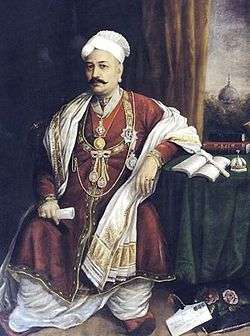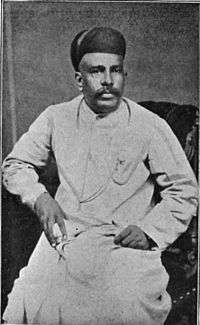Thanjavur Marathi people
  Sir T. Madhava Rao · T. Gopala Rao | |
| Total population | |
|---|---|
| (70,000 appx. (2001)) | |
| Regions with significant populations | |
| Chola Nadu region of Tamil Nadu, Chennai, Dharmapuri district, Kerala | |
| Languages | |
| Thanjavur Marathi (mother tongue), Tamil | |
| Religion | |
| Hinduism | |
| Related ethnic groups | |
| Marathi people, Deshasta Brahmin, Tamil people |
Thanjavur Marathi (colloquially called Rayar)), are a Marathi-speaking ethno-linguistic group, who reside in the central and northern parts of the Indian state of Tamil Nadu. They are the descendants of Marathi administrators, soldiers and noblemen who migrated during the rule of the Thanjavur Maratha kingdom. Thanjavur was a Maratha kingdom in Tamil Country, until the British dethroned the last Thanjavur Maratha king. It was founded by Maratha Warrior Chatrapati Shivaji's brother, Venkoji Rajē Bhonsalē. Kshatriyas use the designation Maratha while Brahmins use the self-designation Deshastha.
Thanjavur Marathi is the mother tongue for over 3% of the total population in the towns of Kumbakonam and Thanjavur.
History
There has been evidence of Marathi immigrants in the Tamil country ever since ancient times. During the Vijayanagar Empire and its aftermath, there was regular movement of people from central India. The Thanjavur Marathi community originated in the 17th century. The first Thanjavur Maratha was Venkoji, also known as Ekoji, a brother of Chattrapathi Shivaji, who established the Thanjavur Maratha kingdom.
In the early years of the Thanjavur Maratha kingdom, migrants to Thanjavur were very few and rare. Most Thanjavur Marathis are descendants of people who migrated during and after the reign of Serfoji I who ruled from 1712 to 1726. Serfoji I invited Brahmins to settle in Thanjavur and offered them vast quantities of land. He also established agraharams such as Sarabhojirajapuram. Migrations to the Tamil country from Maharashtra and northern Karnataka took place throughout the 18th and the first half of the 19th century until the demise of the Thanjavur Maratha kingdom in 1855. Since 1855, migrations have almost ceased. Some aristocratic Thanjavur Marathi families, however, continue to follow the centuries-old custom of concluding marriage alliances only with aristocratic Maratha families of Maharashtra and Central India.
Demographics and distribution
According to the 2001 census, Marathi is spoken as a mother tongue by about 0.1% of the total population of Tamil Nadu.[1] Exact districtwise statistics are not available, but according to estimates, Marathis are mostly concentrated in the city of Chennai and the Thanjavur, Nagapattinam, Dharmapuri, Vellore, Salem, Thiruvannamalai, Tiruvarur, Kanchipuram and Tiruchirappalli districts of Tamil Nadu. The Marathi population in Tamil Nadu has dwindled recently due to migrations to Maharashtra, Bangalore, North India and foreign countries.[2]
Language
The mother tongue of the Thanjavur Marathi people is Thanjavur Marathi, a dialect of the Marathi language. Kannada is also spoken and understood by a significantly large segment of the Thanjavur Marathi population.[3] Having lived in the Tamil country for centuries, almost all Thanjavur Marathis in Tamil Nadu are proficient in Tamil.
Organizations
There are many organizations that support the cause of Thanjavur Marathi people across various parts of India. One of the prominent ones is The Mahratta Education Fund (MEF), a non-profit organization working for the spread of education to poor and deserving students of South Indian Marathi speaking community.[4]
See also
Notes
- ↑ "Census of India - DISTRIBUTION OF 10,000 PERSONS BY LANGUAGE". Government of India. Retrieved 2009-09-23.
- ↑ Gopal, Ashok (August 1986). "Shivaji's Forgotten Cousins" (PDF). Poona Digest.
- ↑ B. N. Krishnamurti Sarma (2000). A history of the Dvaita school of Vedānta and its literature: from the earliest beginnings to our own times. Motilal Banarsidass. p. 544. ISBN 8120815750, ISBN 978-81-208-1575-9.
- ↑ http://mef.4mg.com/
References
- M. Vinayak (January 15, 2000). "Struggle for survival". The Hindu.
- S. Muthiah (July 7, 2003). "The Maharashtrians of T. N.". The Hindu.
- Robert Eric Frykenberg (1968), Elite Formation in Nineteenth Century South India, Proceedings of the First International Conference on Tamil Culture and History, Kuala Lumpur: University of Malaysia Press
- South Indian Maharashtrians (Cultural and Economic Studies), Silver Jubilee Souvenir, Mahratta Education Fund, 1937
